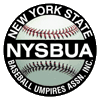The NFHS Baseball Rules Committee and the NFHS Board of Directors believes there are areas of the game of interscholastic baseball that need to be addressed and given special attention. These areas of concern are often cyclical, some areas need more attention than others, and that is why they might appear in the rules book for consecutive editions. These concerns are identified as “Points of Emphasis.” For the 2016 high school baseball season, attention is being called to: intermediate penalties/restriction to the bench/dugout, proper catcher’s equipment, and sportsmanship-celebrations around or near home plate. When a topic is included in the Points of Emphasis, these topics are important enough to reinforce throughout the academic year because they are not being given the proper attention.
Intermediate Penalties/Restriction to the Bench/Dugout
The basic premise for education-based athletics is education. The adult coach and game official work collaboratively to teach, train, oversee, model positive behavior and arbitrate the students under their charge. As part of these “teachable moments” the game official is responsible to maintain order and control the contest so both teams have a fair opportunity to do their best and perform to their highest level.
That responsibility is detailed in NFHS Rule 3, Section 3, Article 1, Bench and Field Conduct and Rule 10, Umpiring. We all should promote preventative officiating. While not listed in the NFHS Rules book, preventative officiating is practiced by the more successful and experienced umpires. Verbal and non-verbal tactics are practiced to let a coach know that you are aware and understand his concern, acknowledge that you are doing your best to officiate the game and that his behavior if negative, is not helpful, in fact it is contributing to the detriment of all that are involved. These are a few key factors in de-escalating a possible contentious exchange.
Under NFHS Rule 3-3-1 and Rule 10, we are provided tools to issue a written warning, then restriction to the bench/dugout and ultimately ejection from the game. Unless the situation calls for such a drastic response, ejections should not be your first option. The lessons best learned by a young person in this environment is by his coach(es). It does not benefit the student if the coach has done something that warrants his removal from the field. Ejections may be avoided by listening to the coach and attempting to understand his perspective prior to responding. A restricted coach may continue to teach, guide and control his team while an ejected coach places this same responsibility upon someone who may not be as prepared for it. Developing preventative officiating skills and using the penalty structure that is in place should make for a healthy and safe environment for all the participants.
Proper Catcher’s Equipment
Because of the significant amount of exposure to thrown or batted balls and thrown bats, the catcher is involved with every pitch and most of the action at or around home plate. It is imperative that they are properly equipped. Prior to start of a baseball game, the head coach verifies that the players are legally and properly equipped. The catcher’s helmet and mask combination shall meet the NOCSAE standard which includes having full ear protection with dual ear flaps. The skull cap and mask combination does not meet the NOCSAE standard nor does it provide full ear protection with dual ear flaps and is not permitted for high school baseball. The catcher shall wear a throat protector which is either attached or part of the catcher’s mask. It shall adequately cover the throat. When a nonadult is in a crouch position and is warming up a pitcher at any location he shall wear face and head protection with throat protection and a protective cup (male only). Ensuring that the catcher is properly equipped will reduce the risk of serious injury and maximizes his enjoyment of the game.
Sportsmanship-Celebrations Around or Near Home Plate
Any walk-off game winning base hit or home run generates immediate excitement for the player who hit the ball, his teammates and fans. Adolescent emotion is at its best when a young person does something successful. Unfortunately, for the team that just gave up the run or lost the game, their emotion is different and being jubilant is not their first thought. Everyone on the winning team wants to congratulate the successful batter as he turns the corner at third base and heads to home plate. The problem is that the umpire-in-chief has to be able to verify that the runner scores.
His job becomes exponentially more difficult if his view is hampered by cheering players along the third base line and around home plate. It is important to keep that area around home plate clear of bodies (and equipment) so the umpire can do his job correctly. In addition, hovering around the third base line and home plate is a perfect opportunity for bad sportsmanship actions with taunting and other boorish behavior. Celebrations will be focused on more diligently because of the number of poor sportsmanship incidents being reported throughout the country.
Whenever a game is ended by a great play or controversial call, emotions typically run high for the unsuccessful side. While winning and losing are perfect “teachable moments” opportunities, disrespectful behavior severely erodes the basic premise of educational-based athletics. When coaches and players allow their emotions to get the best of them and they act badly, the rules allow for warnings, restrictions and ultimately ejections from the contest.

